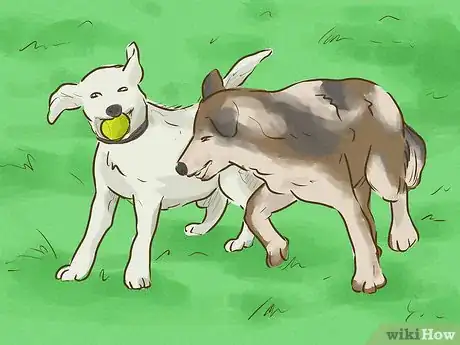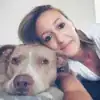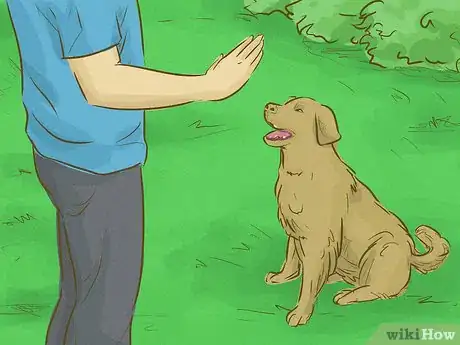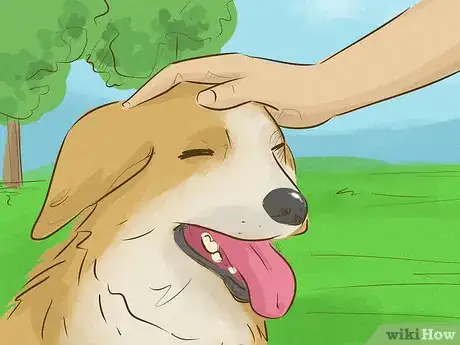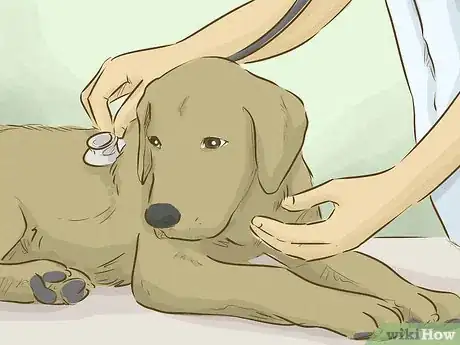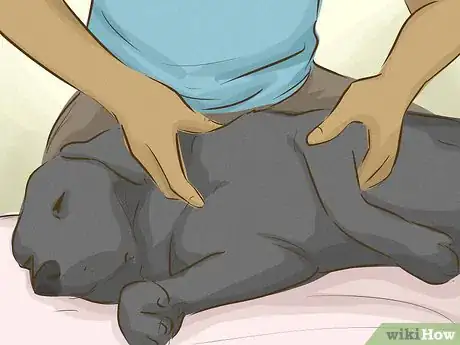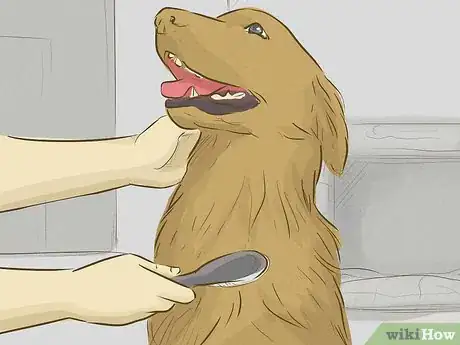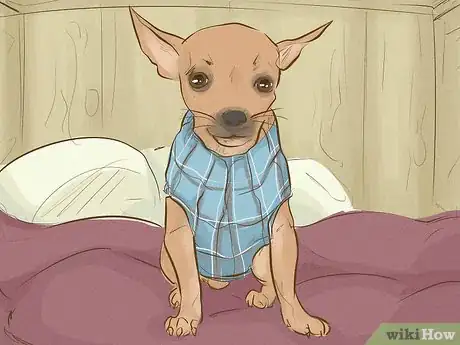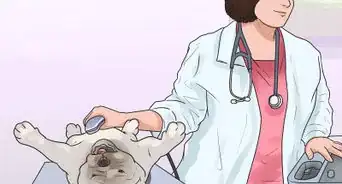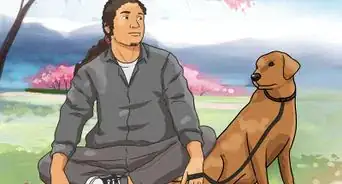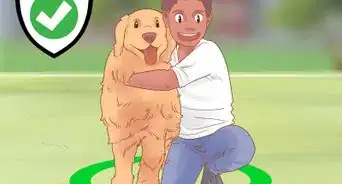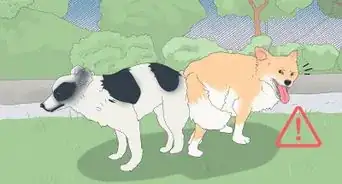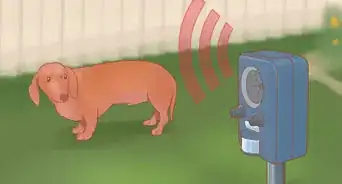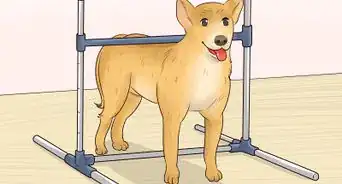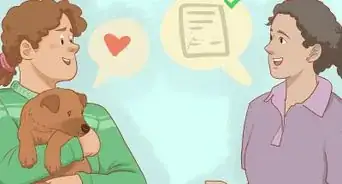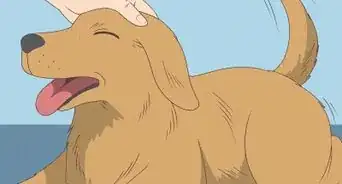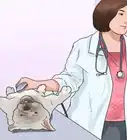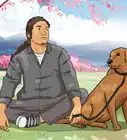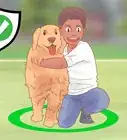This article was co-authored by Jessica Powell. Jessica is a Certified Professional Dog Trainer and the Owner of Proud Paws Dog Training, a small business offering private coaching and in-home dog training services to dog parents across the San Fernando Valley of Los Angeles, California. With nearly ten years of experience, she has extensive knowledge and experience in dog behavior, effective communication techniques, animal welfare, manners training, behavioral modification, and enrichment. Jessica holds a Bachelor of Science degree in Animal Management and is also an experienced shelter professional.
There are 20 references cited in this article, which can be found at the bottom of the page.
wikiHow marks an article as reader-approved once it receives enough positive feedback. This article received 14 testimonials and 100% of readers who voted found it helpful, earning it our reader-approved status.
This article has been viewed 367,836 times.
A dog, also known as human's best friend, is happiest when he's healthy. Ensuring your dog's physical and mental well-being means keeping him stimulated, even when you are not home. Spending time with your pup and providing him with a healthy lifestyle is key to your dog's fulfillment.
Steps
Mental Enrichment
-
1Give your pup a job for when you're gone and he is left alone. Dogs are bred for a specific purpose, whether it be herding or hunting, and can misbehave when these natural instincts are suppressed. [1]
- Create an obstacle course in which your dog follows a scent to his favorite treats.
- Provide him with food puzzle toys, like Kongs, to stimulate his mind.
- Leave him with plenty of chew toys. These will not only strengthen his jaw and teeth, but also keep him from chewing up your shoes instead.
- Hire a dog walker or someone to play with your pet while you’re away.
- Dogs that are bored are more likely to be destructive, so giving your pup things to do when you're not around will help prevent bad behavior.[2]
-
2Socialize your furry friend.[3] [4] Keeping him isolated or at home all day can be detrimental to his emotional well-being and create fear when he finally does come in contact with other people or dogs. But always remember to take your pup’s personality into account so you know what his limits for socializing are. [5]
- Take your dog on a walk, to the dog park, or set up play dates with other humans and their dogs. The goal is to get your dog used to being around other dogs.[6]
- Have a friend, whom your dog knows and trusts, look after your pet once a week to get him used to other people.
- If your dog has a cautious demeanor, introduce him to one dog at a time, and only if the other dog is calm and won't frighten your pup. [7]
Advertisement -
3
-
4Establish yourself as pack leader and never waiver. It’s important to show your dog love and affection, but he is a tribal animal above all else. Your pooch will become confused without structure and consistency in his life, so be sure you stick to your role. [11]
- Playtime is only for when he is calm and receptive.
- Reward your pup with special treats when he has followed your directions.
- During walks your dog should be next to or behind you.
-
5Remain calm and assertive around your dog. Never behave uneasy or anxious. Because you are the pack leader, these feelings are sure to rub off on your pet.
- Nervous animals are more likely to be aggressive. [12]
-
6Maintain your dog’s confidence. Believe it or not, your pup does have self-esteem, and there are things that you, as his owner, can do to keep it up. Praise your dog when he has mastered a new trick, along with other accomplishments.
- Remember that your tone of voice is the key to communication with your pet; praise for him should sound different than a command[13]
Physical Care
-
1Keep your pup active. Especially if he is alone all day, a dog needs exercise just like people do.[14] [15] Take your dog on a walk around the block or play a fun, interactive game with him. [16]
- Hide and seek will stimulate your pet’s mind and body.
- If you have a high-energy breed, your dog could benefit from an agility class, which may be offered through your local shelter.
- A puppy is especially precocious, so active games like tug-of-war and fetch will burn some energy and help to socialize him. [17]
- For an older dog with stiff joints, water activities are a safe, low impact source of exercise.
- If you have a small dog, consider finding a dog park that has specified areas where your pet can socialize with pup's his own size and temperament so you don't have to be skeptical of his safety.
-
2Feed your dog a nourishing, balanced diet. An animal is happiest when he can exercise, and to do so, he must eat healthful food. What you feed your pooch depends on his age, energy level and potential allergies. Organic, grain free kibble is always best if you are going to go the commercial route. However, some veterinarians also swear by feeding dogs “people food”. Dog-approved people foods include:
- Raw, unsalted peanut butter
- Baby carrots
- Pumpkin
- Green beans
- Sliced apples
- Oatmeal [18]
-
3Schedule regular veterinary appointments for your pet. The vet will provide an overall health screening, as well as any vaccinations your dog might need. It's best for puppies and older dogs to visit every six months, while once a year is adequate for adult dogs under the age of ten. [19]
- This visit can also help you determine methods for keeping your dog’s ears and teeth clean, along with any other hygiene concerns.
-
4Ensure your dog’s safety at all times. This includes making sure he has an ID tag on him, a fenced yard that will keep him safe from potential predators, and plenty of shade and water if he’s outside during warm weather.
- Make sure your dog is securely fastened or confined during car trips and never let his head hang out of the window where he could be hit by airborne objects or thrown from the vehicle. [20]
- Unless your dog is extremely well trained, leashing him when outside the yard is important, especially if you’re in a high traffic area.
- Kids should always be supervised around a dog; young children should also never be allowed to hold a small dog as they can accidentally drop or injure him.[21]
-
5Give your pup regular massages. This will bring down his stress levels and soothe any joint pain he may be experiencing.
- A slow rub down that reaches the muscle, fat and bones can work wonders to calm a nervous dog.
- Daily massages can prolong the length and quality of your canine’s life.
- Rubbing your dog’s joints can prepare him for physical activity and help him to unwind directly after.[22]
- Great Danes and Mastiffs are especially prone to arthritis, so aside from a daily massage, nutritional supplements can be considered to keep these breeds healthy and pain free. [23]
Breed-Specific Tips
-
1Be sure to brush, comb, and trim your Golden Retriever’s coat regularly. Your Golden is especially prone to allergies and matting of his thick coat. Keeping his fur clean will help his skin from getting itchy and also better serve as insulation during the hot summer and cold winter. [24]
- As a bonus, he won’t shed quite as much on your furniture.
- Pay special attention to the feathering of his tail and legs which can get tangled easily, causing your Golden discomfort.
-
2Set aside at least two hours a day to give your Pit Bull attention. While this breed is known for his loyalty and devotion, he needs a lot of quality time with you so he doesn’t get bored and destructive. [25]
- The high-energy Pit Bull isn’t the type you can leave alone or put outside for the entire day.
- This athletic breed enjoys swimming, running, playing fetch or frisbee, along with most other sports.
- Because he is a social butterfly, a well-trained Pit Bull appreciates human interaction, including time with your friends, family and even strangers, so be sure to get him out of the house.[26]
-
3Keep your Chihuahua warm in cold or wet weather. This must be taken seriously since the Chihuahua, like some other small breeds, has trouble regulating his own body temperature, and doesn’t have a large amount of insulating fur. [27]
- A Chihuahua is generally content to be cuddled up on his owners lap, both for affection and warmth.
- Investing in a sweater for your Chihuahua will help keep him from shivering when he's outside.
-
4Be sure your terrier has toys with which to entertain himself, especially when left alone. While a terrier is a fairly independent dog, he does require a fair amount of exercise. This dog doesn't require your supervision all day as long as you give him the means to play safely on his own. [28]
- If your terrier is left with nothing to occupy himself, he may resort to digging or other destructive forms of entertainment.
- He is especially fond of other canine companionship and playtime can be beneficial for socializing terrier breeds.
Expert Q&A
Did you know you can get expert answers for this article?
Unlock expert answers by supporting wikiHow
-
QuestionHow can I help my puppy with their separation anxiety?
 Osama MaghawriOsama Maghawri is a Dog Trainer and Founder of OneStopK9, a dog training service in Miami, Florida. Osama utilizes balanced training methods to teach communication between owners and dogs. He specializes in basic obedience and behavioral issues such as resource guarding, fear-based aggression, and leash reactivity. Osama also helps owners understand the behaviors of their breed and how to continue training on their own in the future.
Osama MaghawriOsama Maghawri is a Dog Trainer and Founder of OneStopK9, a dog training service in Miami, Florida. Osama utilizes balanced training methods to teach communication between owners and dogs. He specializes in basic obedience and behavioral issues such as resource guarding, fear-based aggression, and leash reactivity. Osama also helps owners understand the behaviors of their breed and how to continue training on their own in the future.
Professional Dog Trainer I recommend using a crate. A lot of people don't realize that puppies should be sleeping about 85% of the day, very similar to babies. They need to be taking a lot of naps so that they do not get overstimulated. Keep them in the crate to nap for about 2-3 hours, then play with them, feed them, and let them use the bathroom. After engaging with them, encourage them to go back in the crate. When you follow that structure, you can prevent behaviors like separation anxiety from happening.
I recommend using a crate. A lot of people don't realize that puppies should be sleeping about 85% of the day, very similar to babies. They need to be taking a lot of naps so that they do not get overstimulated. Keep them in the crate to nap for about 2-3 hours, then play with them, feed them, and let them use the bathroom. After engaging with them, encourage them to go back in the crate. When you follow that structure, you can prevent behaviors like separation anxiety from happening. -
QuestionWhat if my dog gets bored even if I give him attention?
 Community AnswerTry to play one of his favorite games or give him one of his favorite toys. If he is still bored, you can make up a new game, or a give him new toy to play with. If your dog is still bored, he might just not feel like playing that day, or he might be sick. consider looking for signs of illness; if you suspect something, contact your vet.
Community AnswerTry to play one of his favorite games or give him one of his favorite toys. If he is still bored, you can make up a new game, or a give him new toy to play with. If your dog is still bored, he might just not feel like playing that day, or he might be sick. consider looking for signs of illness; if you suspect something, contact your vet. -
QuestionHow can I keep my dog happy if she doesn't like toys?
 Community AnswerTake her out for runs and walks, spend time in nature together, give her special treats and belly rubs and pet her while she lays next to you.
Community AnswerTake her out for runs and walks, spend time in nature together, give her special treats and belly rubs and pet her while she lays next to you.
References
- ↑ http://www.aspca.org/pet-care/virtual-pet-behaviorist/dog-behavior/separation-anxiety
- ↑ Indigo Will. Professional Canine Expert. Expert Interview. 8 September 2020.
- ↑ Jessica Powell. Certified Professional Dog Trainer. Expert Interview. 5 October 2021.
- ↑ Osama Maghawri. Professional Dog Trainer. Expert Interview. 9 September 2020.
- ↑ http://moderndogmagazine.com/articles/what-your-dog-really-wants/31472
- ↑ Indigo Will. Professional Canine Expert. Expert Interview. 8 September 2020.
- ↑ http://www.animalhumanesociety.org/training/socializing-adult-dog
- ↑ Jessica Powell. Certified Professional Dog Trainer. Expert Interview. 5 October 2021.
- ↑ Osama Maghawri. Professional Dog Trainer. Expert Interview. 9 September 2020.
- ↑ http://www.aspca.org/pet-care/virtual-pet-behaviorist/dog-behavior/enriching-your-dogs-life
- ↑ http://www.cesarsway.com/dog-behavior/basics/5-things-that-drive-us-crazy
- ↑ http://www.cesarsway.com/dog-behavior/basics/5-things-that-drive-us-crazy
- ↑ https://atlanticstatesbriardclub.org/voice.htm
- ↑ Osama Maghawri. Professional Dog Trainer. Expert Interview. 9 September 2020.
- ↑ Jessica Powell. Certified Professional Dog Trainer. Expert Interview. 5 October 2021.
- ↑ http://moderndogmagazine.com/articles/what-your-dog-really-wants/31472
- ↑ http://www.aspca.org/pet-care/virtual-pet-behaviorist/dog-behavior/teaching-your-dog-play-tug-war
- ↑ https://www.cesarsway.com/dog-approved-people-food/
- ↑ http://www.vcahospitals.com/main/pet-health-information/article/animal-health/wellness-examination-in-dogs/4988t
- ↑ https://www.avma.org/public/PetCare/Pages/pets-in-vehicles.aspx
- ↑ https://www.aspca.org/pet-care/virtual-pet-behaviorist/dog-behavior/teaching-your-dog-how-behave-around-children
- ↑ https://moderndogmagazine.com/articles/how-massage-your-dog/2028
- ↑ https://www.aspca.org/pet-care/dog-care/arthritis
- ↑ http://moderndogmagazine.com/breeds/golden-retriever
- ↑ http://www.local.com/topics/household/five-tips-for-raising-a-happy-pit-bull-terrier-1795.aspx
- ↑ Osama Maghawri. Professional Dog Trainer. Expert Interview. 9 September 2020.
- ↑ http://moderndogmagazine.com/breeds/chihuahua-0
- ↑ http://www.pets4homes.co.uk/pet-advice/keeping-terrier-type-dogs-happy.html
About This Article
To keep your dog happy, spend time training and playing with your dog to strengthen your bond and keep it physically fit. When training your dog, use a calm, assertive tone of voice and avoid yelling. Give your furry friend plenty of toys, especially when you're not at home, to provide entertainment and mental stimulation. Don't forget to feed your dog a nourishing, balanced diet and take it to the vet annually for a checkup! For tips on keeping different breeds happy, read on!


